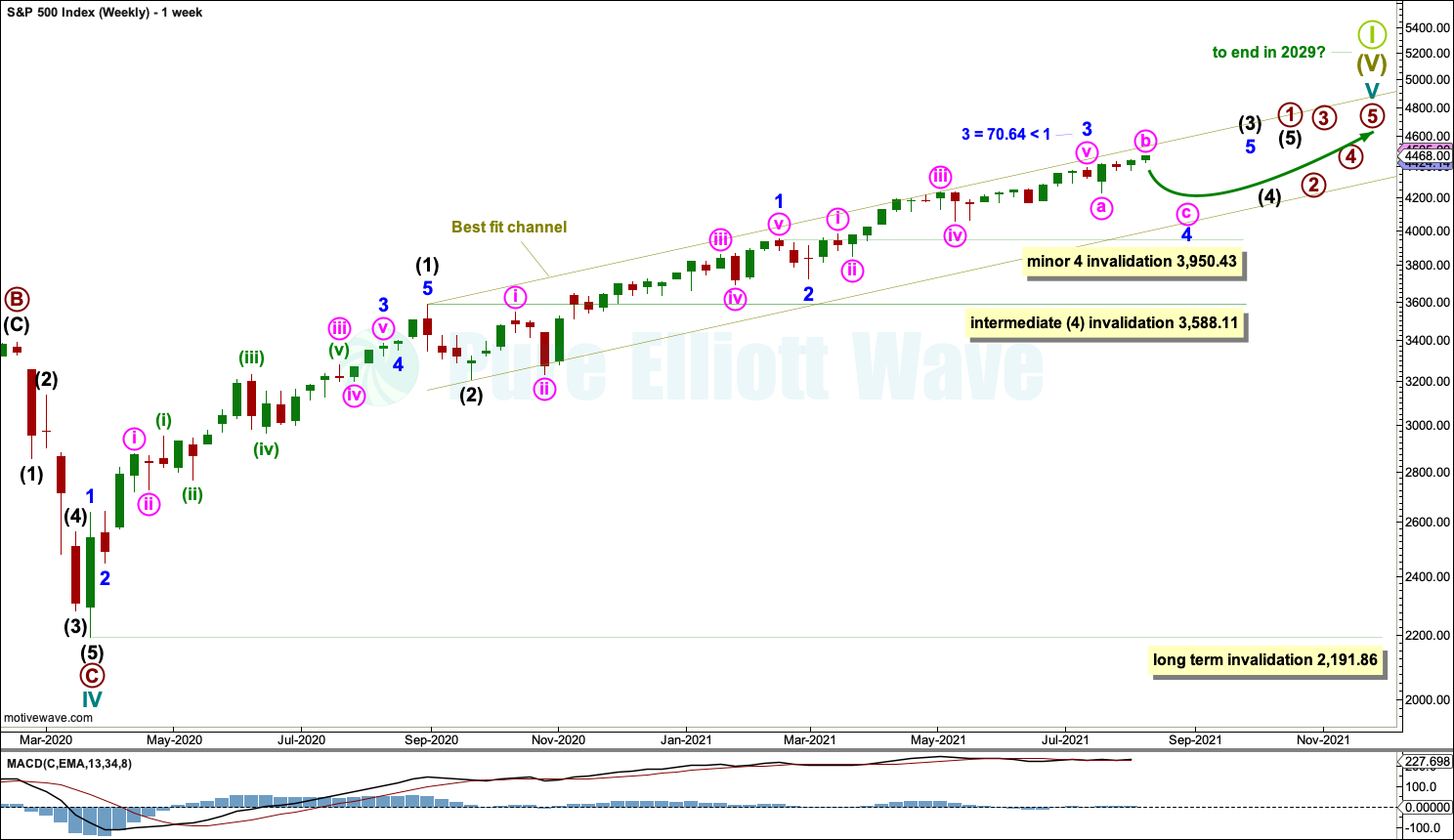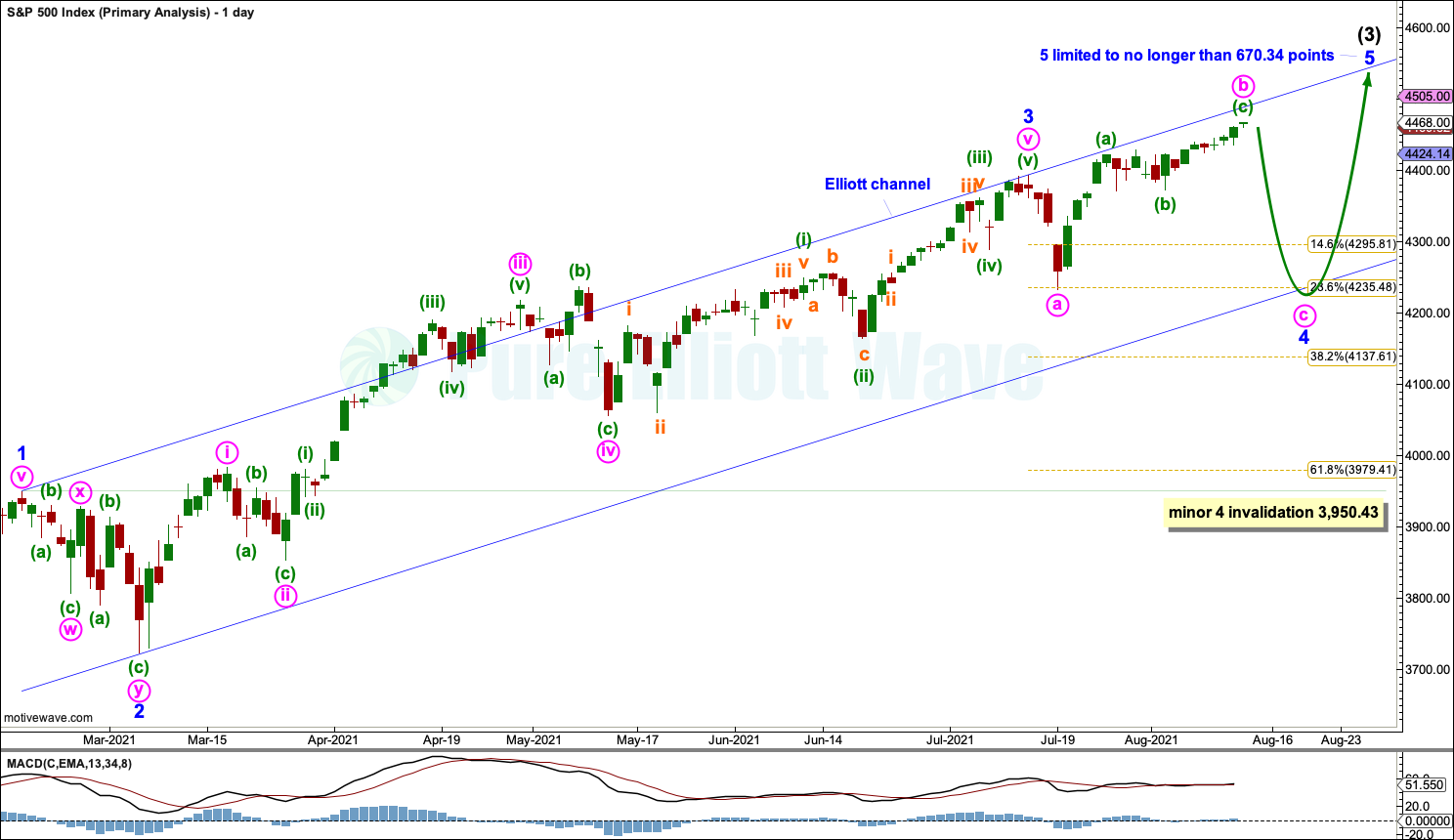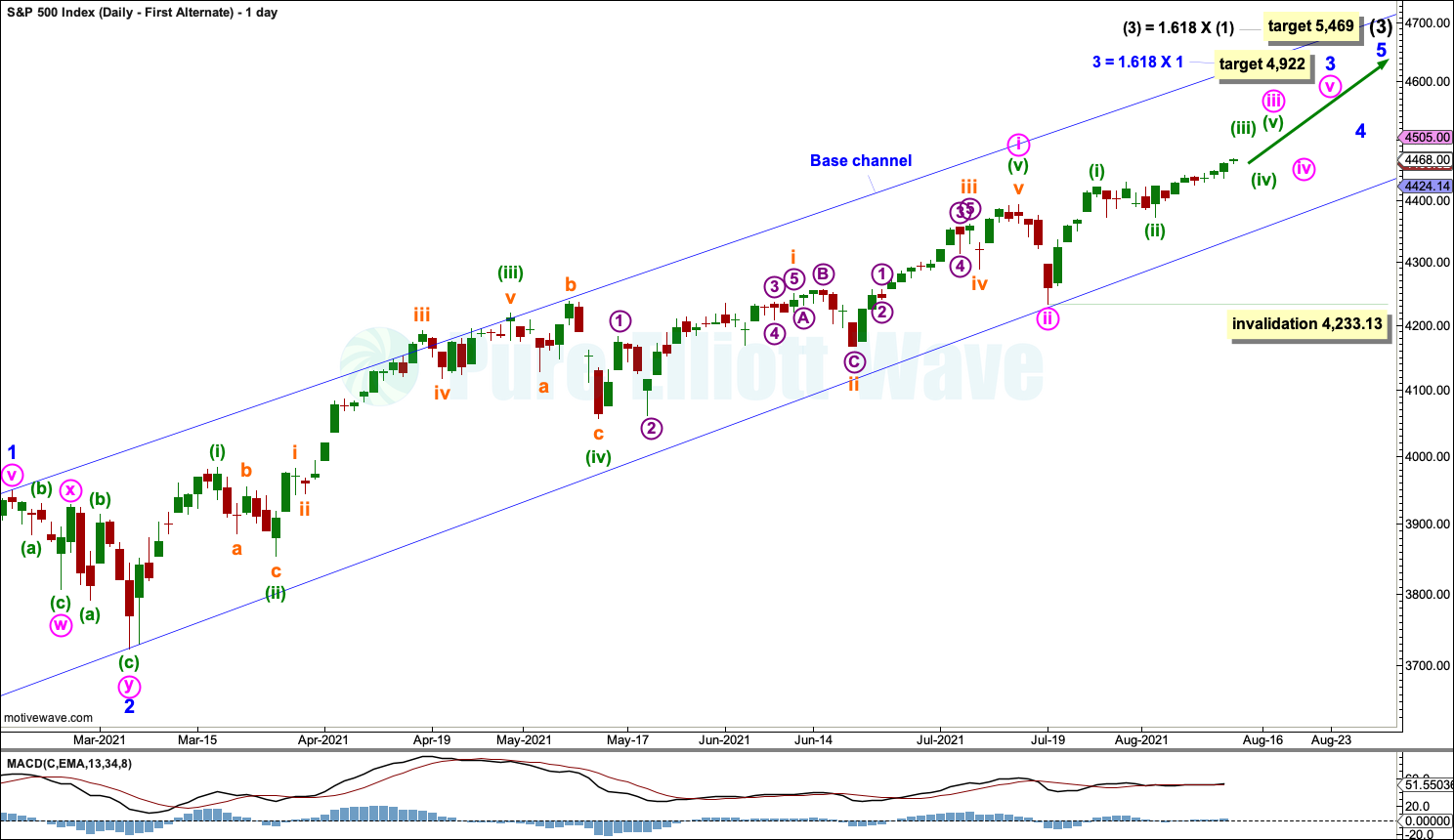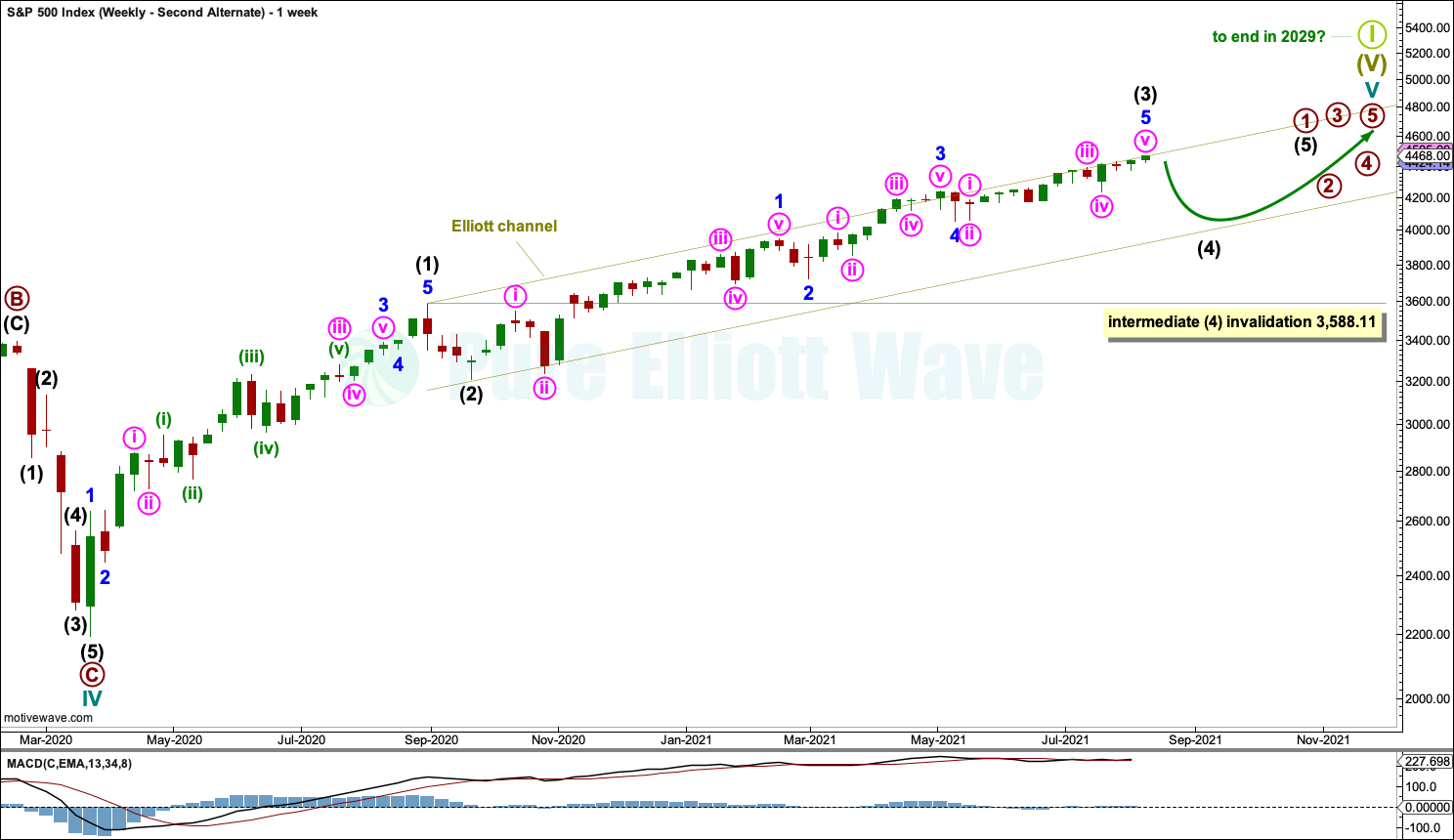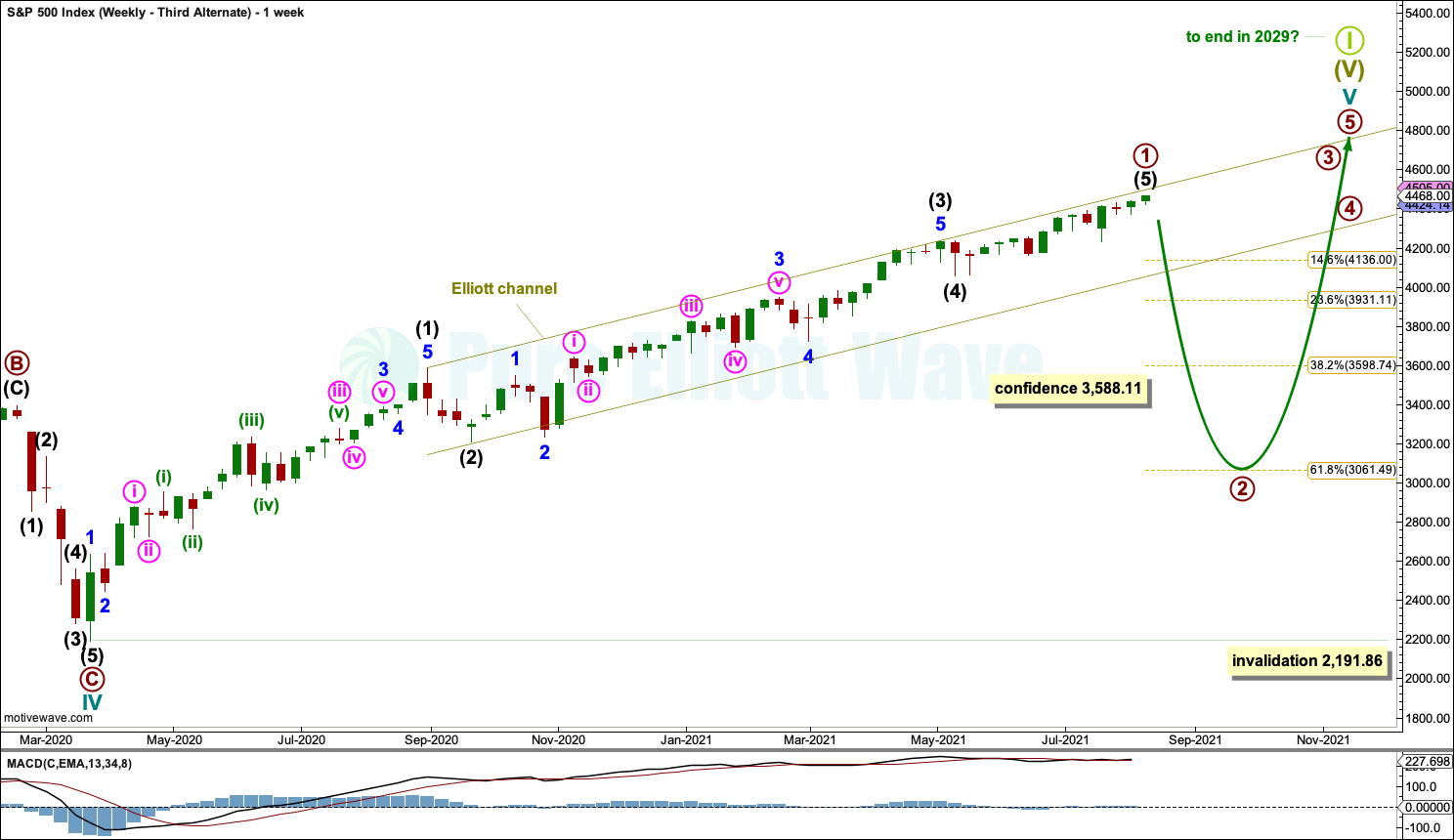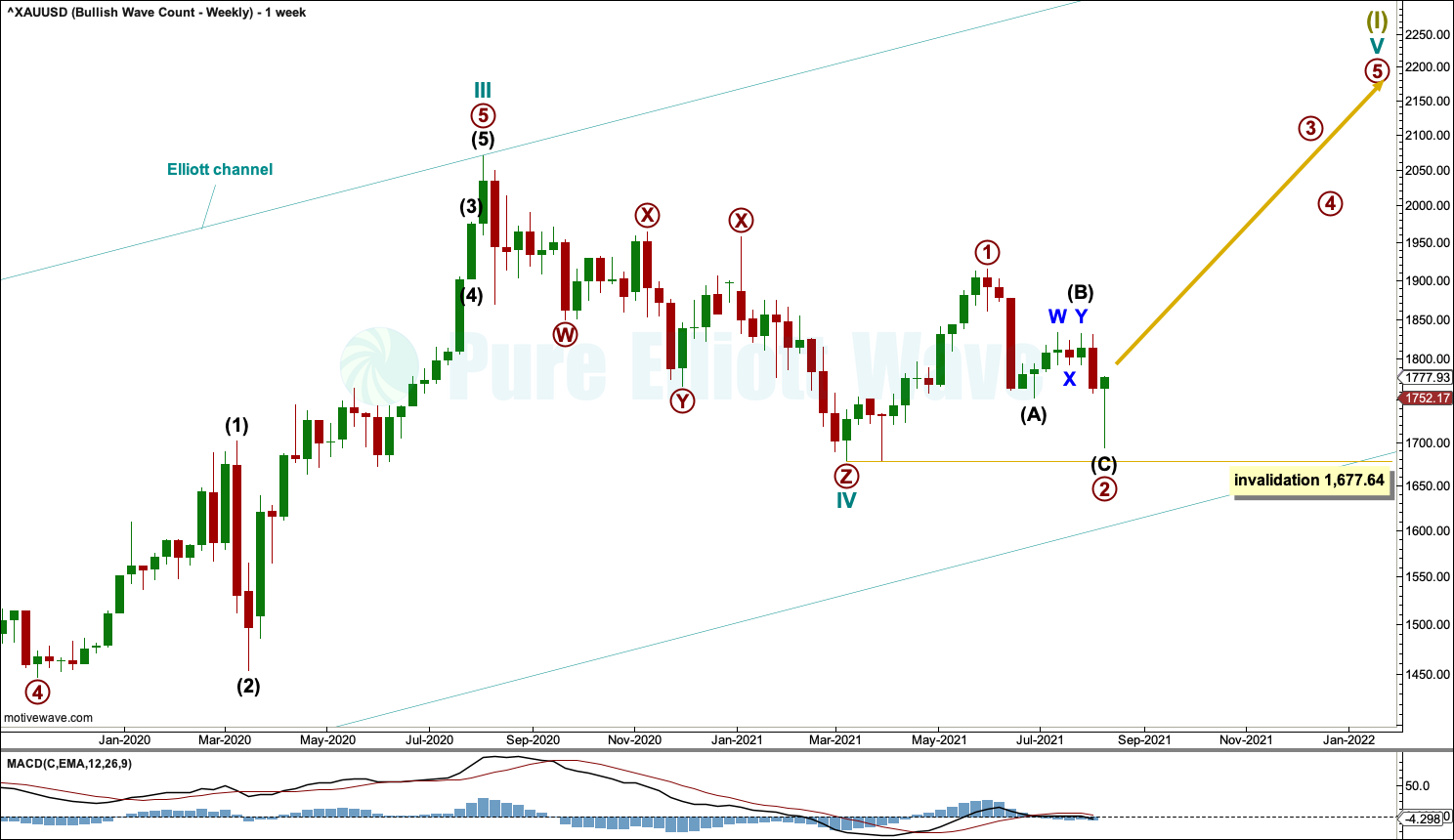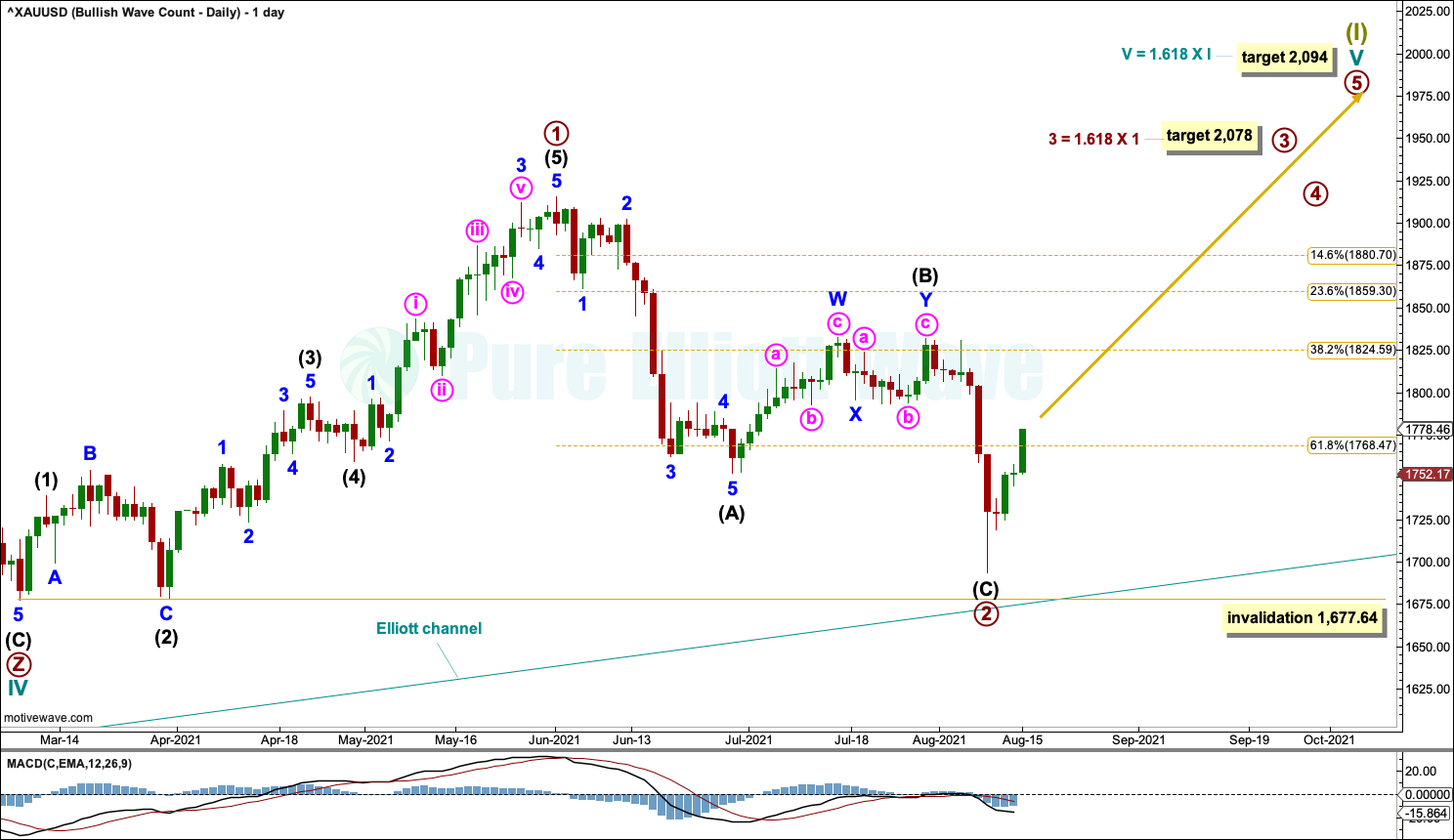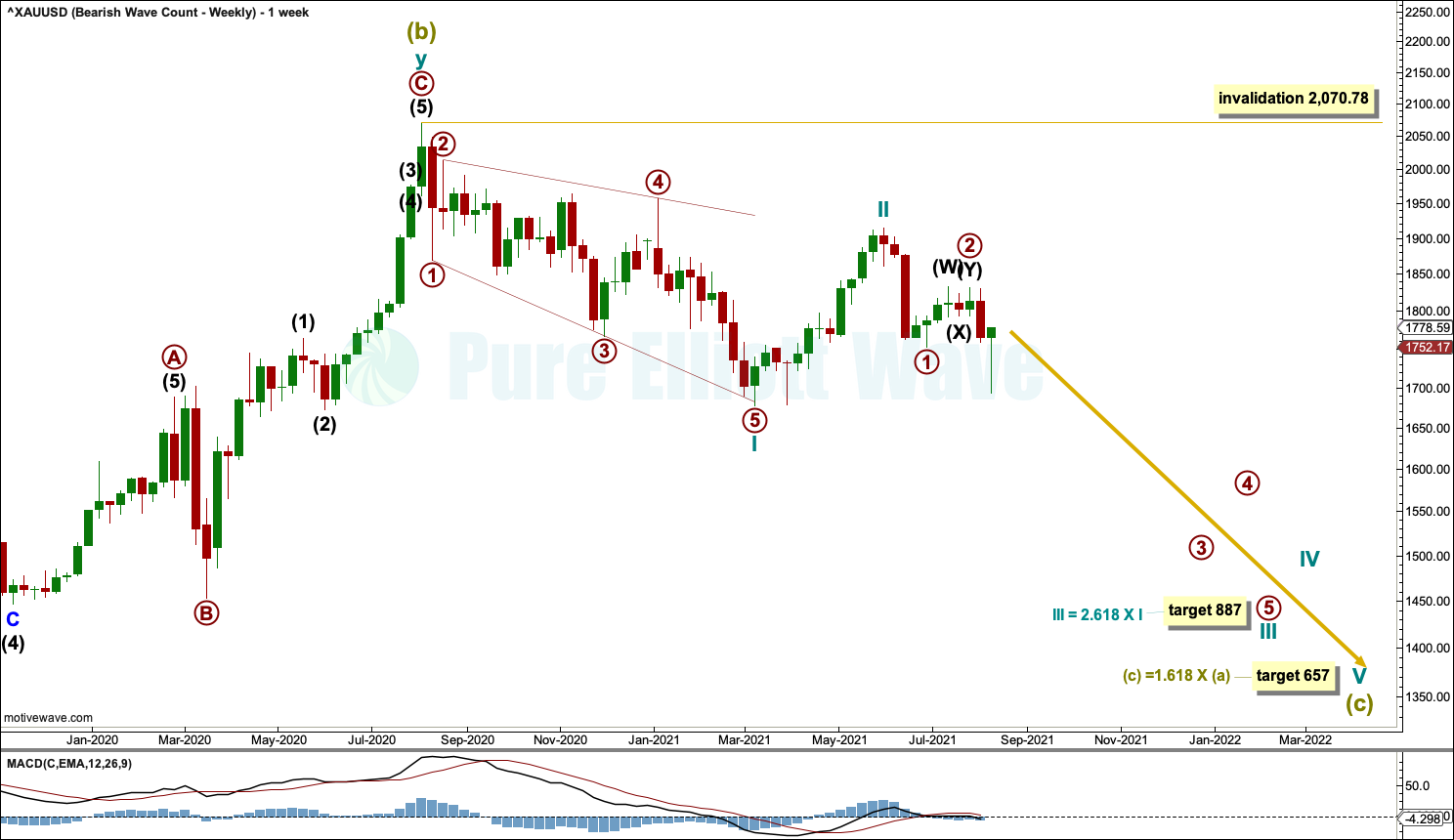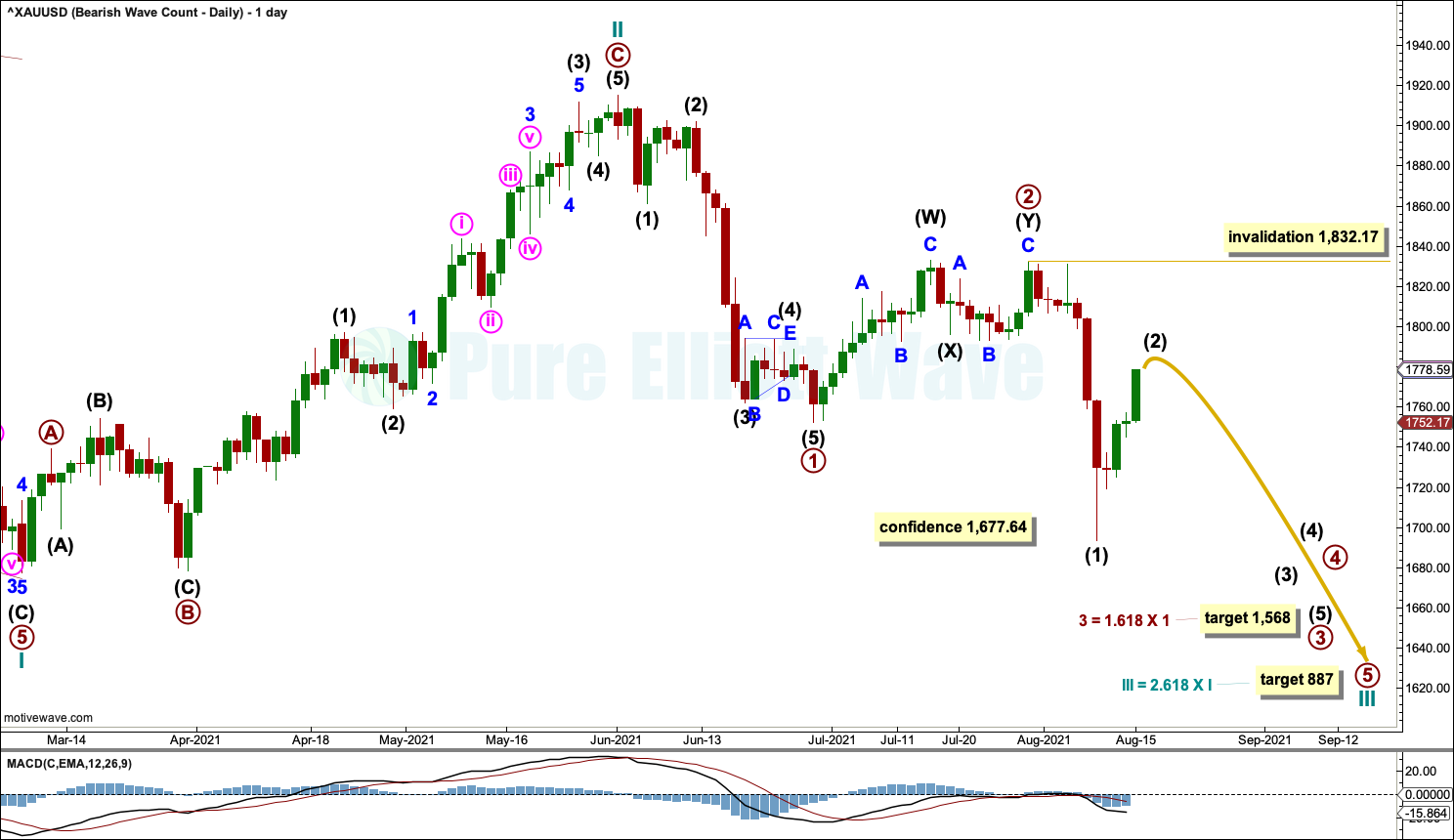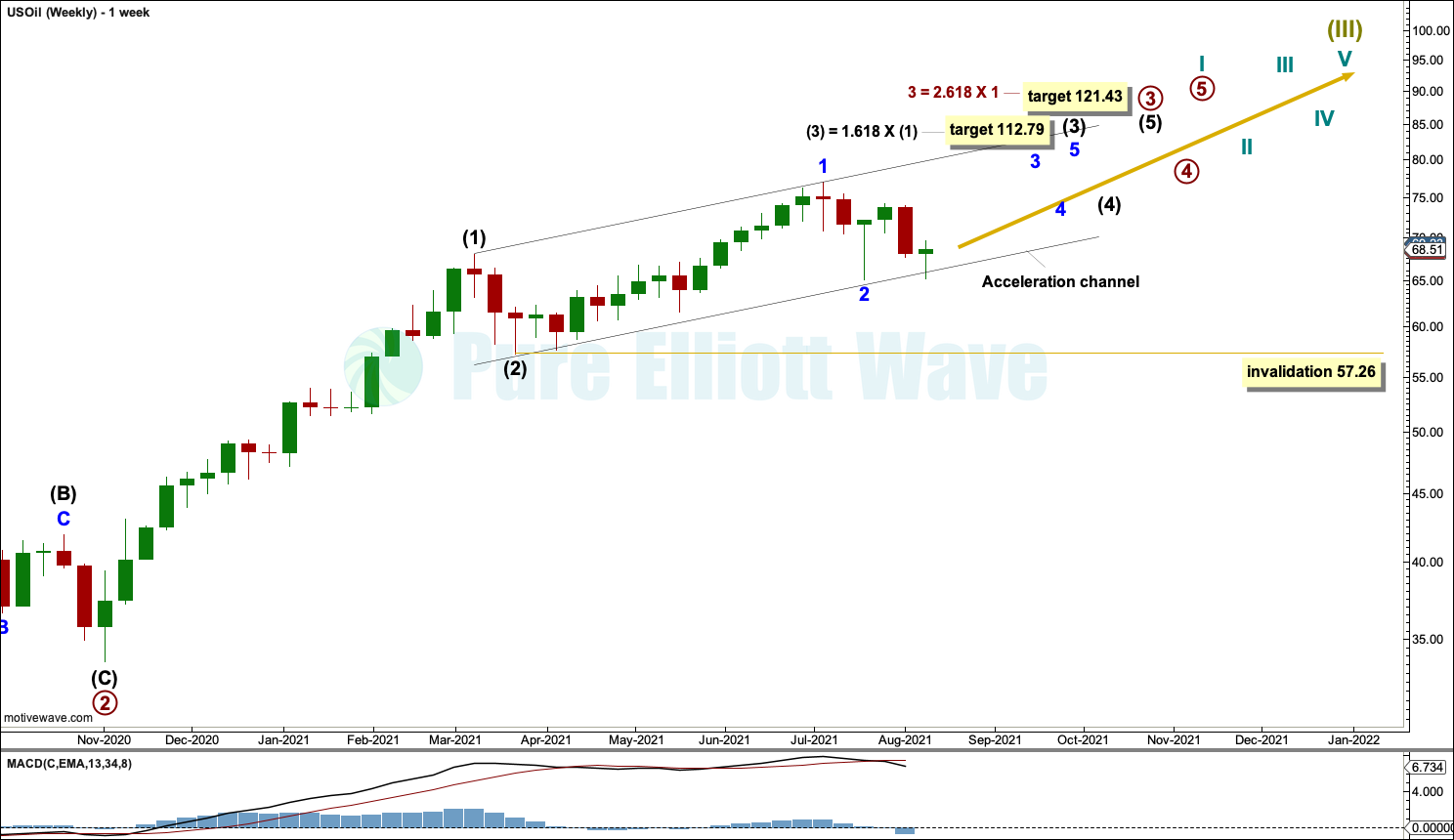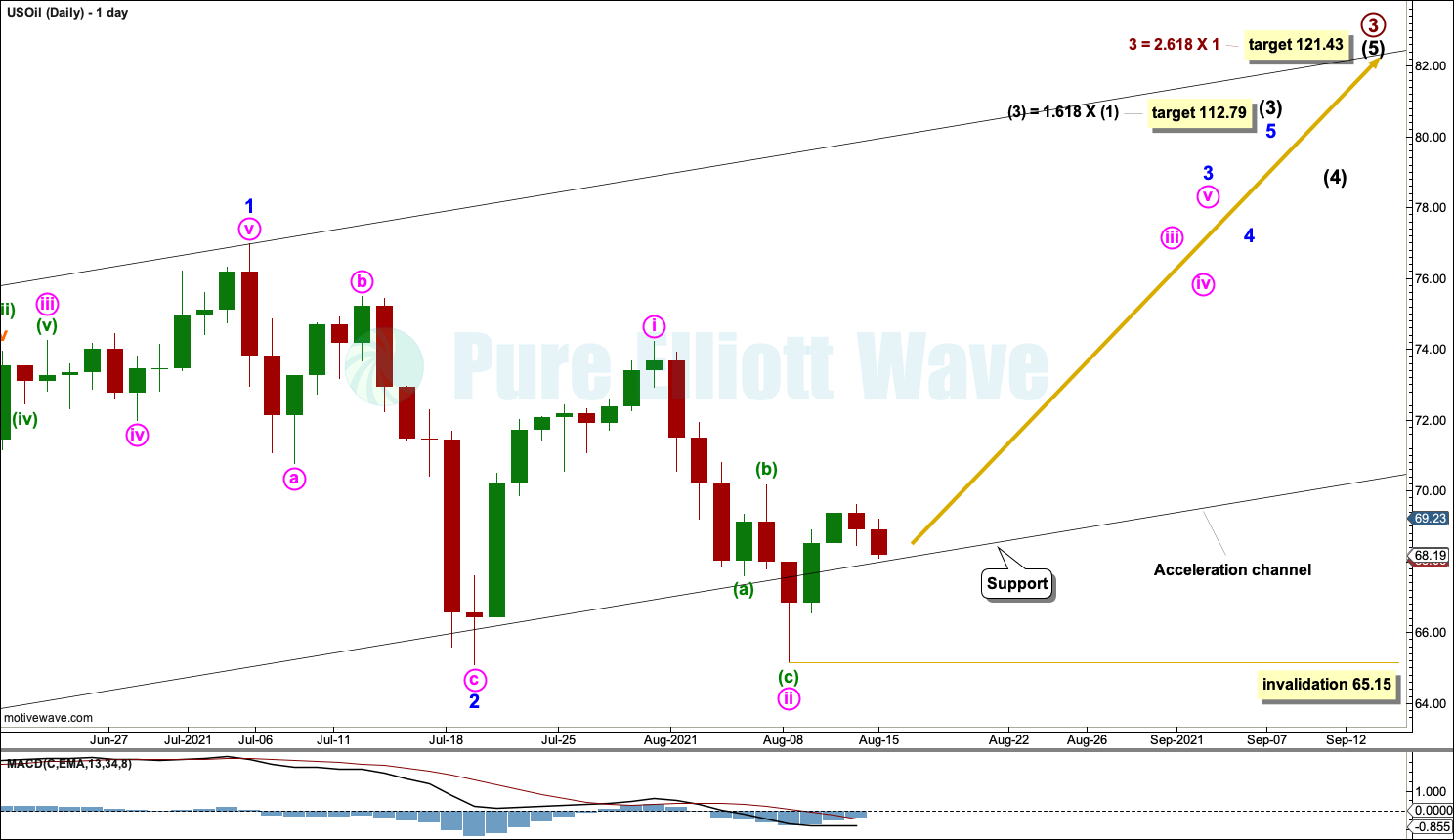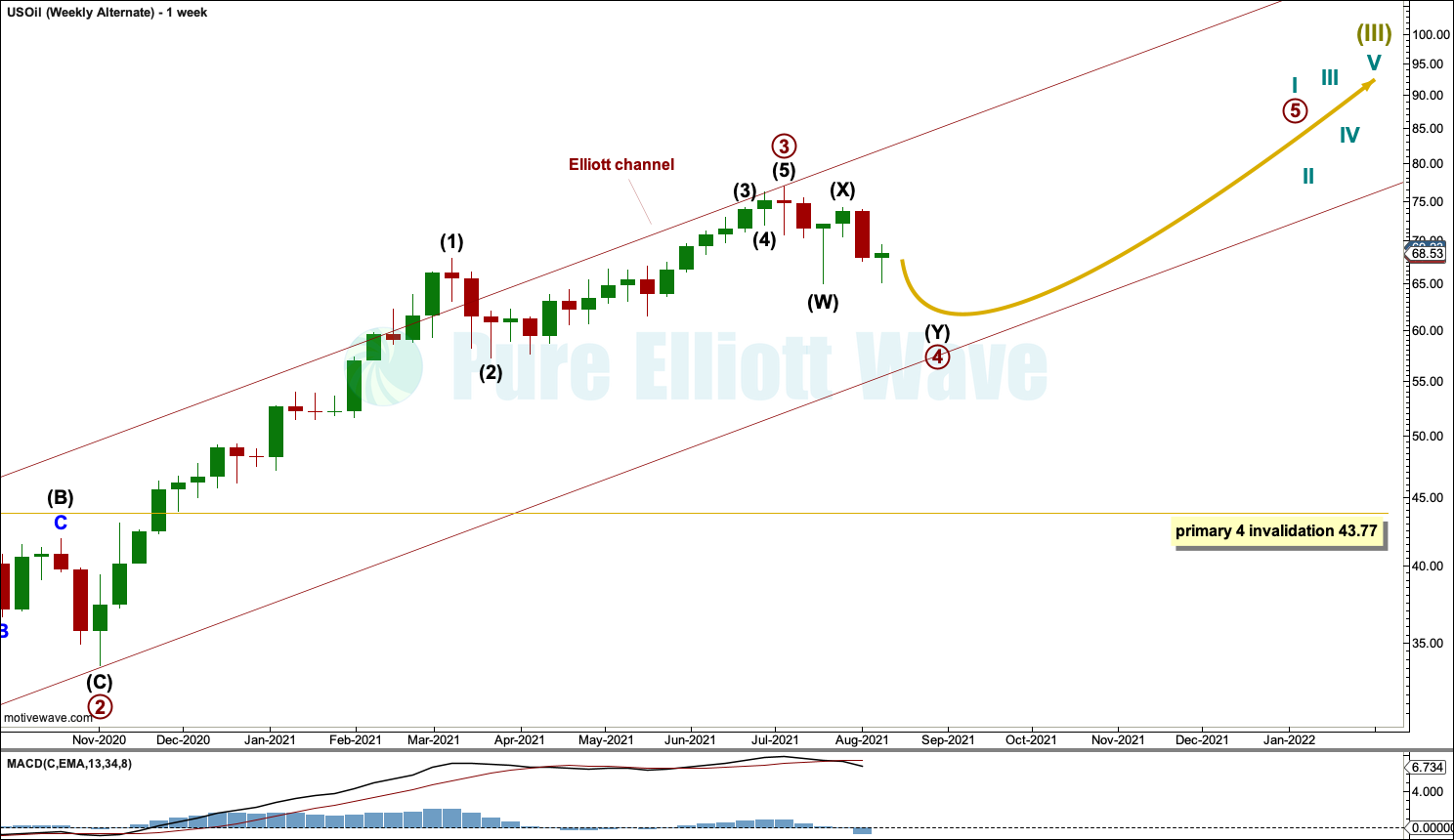Lara’s Weekly: Elliott Wave and Technical Analysis of S&P500 and Gold and US Oil | Charts – August 13, 2021

S&P 500
Four Elliott wave counts are considered at the end of this week.
The main Elliott wave count remains the same because of technical evidence of weakness.
Summary: There is still a reasonably strong cluster of bearish signals from the AD line, but short-term weak bearish divergence between price and RSI has weakened further and is now only triple. Four Elliott wave counts are considered in order of probability:
1 – A minor degree fourth wave may see a pullback beginning here or very soon. The pullback would likely end below 4,233.13.
2 – The upwards trend has resumed to the next target at 4,922 (first alternate).
3 – An intermediate degree fourth wave on the weekly chart may move suddenly lower to find support about the lower edge of the Elliott channel, which sits about 3,956 (second alternate).
4 – A primary degree second wave may begin. It may meet the technical definition of a bear market in that it may correct to 20% or more of market value at its eventual low. Also, it may find support about 3,044 and may not make a new low below 2,191.86 (third alternate – highly unlikely now).
The biggest picture, Grand Super Cycle analysis, is here.
Last monthly charts are here. Video is here.
MAIN ELLIOTT WAVE COUNT
WEEKLY CHART
Cycle wave V may last from one to several years. So far it is in its seventeenth month.
This wave count may allow time for the AD line to diverge from price as price makes final highs before the end of the bull market. The AD line most commonly diverges a minimum of 4 months prior to the end of a bull market. A longer divergence is positively correlated with a deeper bear market. A shorter divergence is positively correlated with a more shallow bear market. There is now only eighteen days of divergence.
A longer divergence between price and the AD line would be expected towards the end of Grand Super Cycle wave I.
It is possible that cycle wave V may continue until 2029, if the 2020s mirror the 1920s. Either March or October 2029 may be likely months for the bull market to end.
Cycle wave V would most likely subdivide as an impulse. But if overlapping develops, then an ending diagonal should be considered. This chart considers the more common impulse.
There is already a Fibonacci ratio between cycle waves I and III within Super Cycle wave (V). The S&P500 often exhibits a Fibonacci ratio between two of its actionary waves but rarely between all three; it is less likely that cycle wave V would exhibit a Fibonacci ratio. The target for Super Cycle wave (V) to end would best be calculated at primary degree, but that cannot be done until all of primary waves 1, 2, 3 and 4 are complete.
Primary wave 1 within cycle wave V may be incomplete. This gives a very bullish wave count, expecting a long duration for cycle wave V which has not yet passed its middle strongest portion.
Within primary wave 1: Intermediate waves (1) and (2) may be complete, and intermediate wave (3) may now be approaching an end.
Intermediate wave (4) may not move into intermediate wave (1) price territory below 3,588.11.
Within intermediate wave (3), minor waves 1, 2 and 3 may be complete. Minor wave 3 may be shorter than minor wave 1 by 70.64 points. This limits minor wave 5 to no longer than equality in length with minor wave 3. Minor wave 4 may not move into minor wave 1 price territory below 3,950.43.
A best fit channel is drawn about cycle wave V. Draw the first trend line from the end of intermediate wave (1) to the end of minute wave iii within minor wave 3, then place a parallel copy on the end of intermediate wave (2). The channel may need to be redrawn as price continues higher. The channel may show where price may find resistance and support along the way up.
DAILY CHART
Minor wave 2 subdivided as a double zigzag and lasted 12 sessions. Minor wave 4 may last about 3 to 6 weeks and may most likely subdivide as a flat, triangle or combination, which are often longer lasting than zigzags.
The most likely structure for minor wave 4 at this stage looks like an expanded flat, which is a very common structure. Minute wave c within minor wave 4 would be likely to make at least a slight new low below the end of minute wave a at 4,233.13 to avoid a truncation and a very rare running flat.
Draw an Elliott channel. Draw the first trend line from the ends of minor waves 1 to 3, then place a parallel copy on the end of minor wave 2. Minor wave 4 may find support about the lower edge of this channel. It may also overshoot the channel.
Minor wave 4 may not move into minor wave 1 price territory below 3,950.43.
If minor wave 3 is over, then it would be 70.64 points shorter than minor wave 1. This limits minor wave 5 to no longer than equality in length with minor wave 3, so that the core Elliott rule stating a third wave may never be the shortest is met.
When expanded flats unfold, it is extremely difficult to identify them as their B waves make new price extremes beyond the start of their A waves. In a bull market that means price continues higher while a correction for wave C is expected. The key to identifying expanded flats is to look for reasonable weakness within the B wave. In this case there is reasonable technical evidence of weakness in breadth, volume and divergence with price and RSI. While this weakness remains, this must remain the main wave count based upon a judgement of balance of probability.
FIRST ALTERNATE
DAILY CHART
This alternate wave count has a lower probability than the main Elliott wave count based upon bearishness in classic technical analysis. It is named first alternate mostly because we should always expect the trend remains the same until proven otherwise. With new all time highs again this week, the S&P is still within an upwards trend. However, the cluster of bearish signals puts this wave count still behind the main wave count at this stage.
If the degree of labelling within minor wave 3 is moved down one degree, then only minute wave i within minor wave 3 may be complete.
Minute wave ii within minor wave 3 may be over at the last swing low. A third wave up at minute, minor and intermediate degrees may have begun.
Targets are calculated for minor wave 3 and intermediate wave (3) that expect common Fibonacci ratios.
No second wave correction within minute wave iii may move beyond its start below 4,233.13.
SECOND ALTERNATE
WEEKLY CHART
This weekly chart is still considered.
It is possible that intermediate wave (3) is over at the last high. However, it may also continue a little higher.
Intermediate wave (4) may last from three to several weeks and may find support about the lower edge of the Elliott channel. Intermediate wave (4) may not move into intermediate wave (1) price territory below 3,588.11.
Intermediate wave (3) is shorter than intermediate wave (1) by 137.33 points. It is unusual for third waves to be shorter than first waves for the S&P, particularly of a higher degree such as intermediate. This reduces the probability of this alternate wave count.
This alternate wave count is considered because the bearish divergence between price and the AD line is strong.
THIRD ALTERNATE
WEEKLY CHART
This third alternate Elliott wave count is considered because it is technically possible. However, primary wave 2 may correct to the 0.618 Fibonacci ratio, which would be a 31.5% reduction in market value and meet the technical definition of a bear market. This is possible but has a very low probability as there is only 30 days of bearish divergence between price and the AD line. Within the last (almost) 100 years, only three bear markets have occurred following less than 4 months bearish divergence between price and the AD line. If this wave count is correct, then it would exhibit bearish divergence of less than 4 months a fourth time in almost 100 years; the probability of this alternate is rather low.
Primary wave 2 may last one to a few months. It may not move beyond the start of primary wave 1 below 2,191.86.
TECHNICAL ANALYSIS
WEEKLY CHART
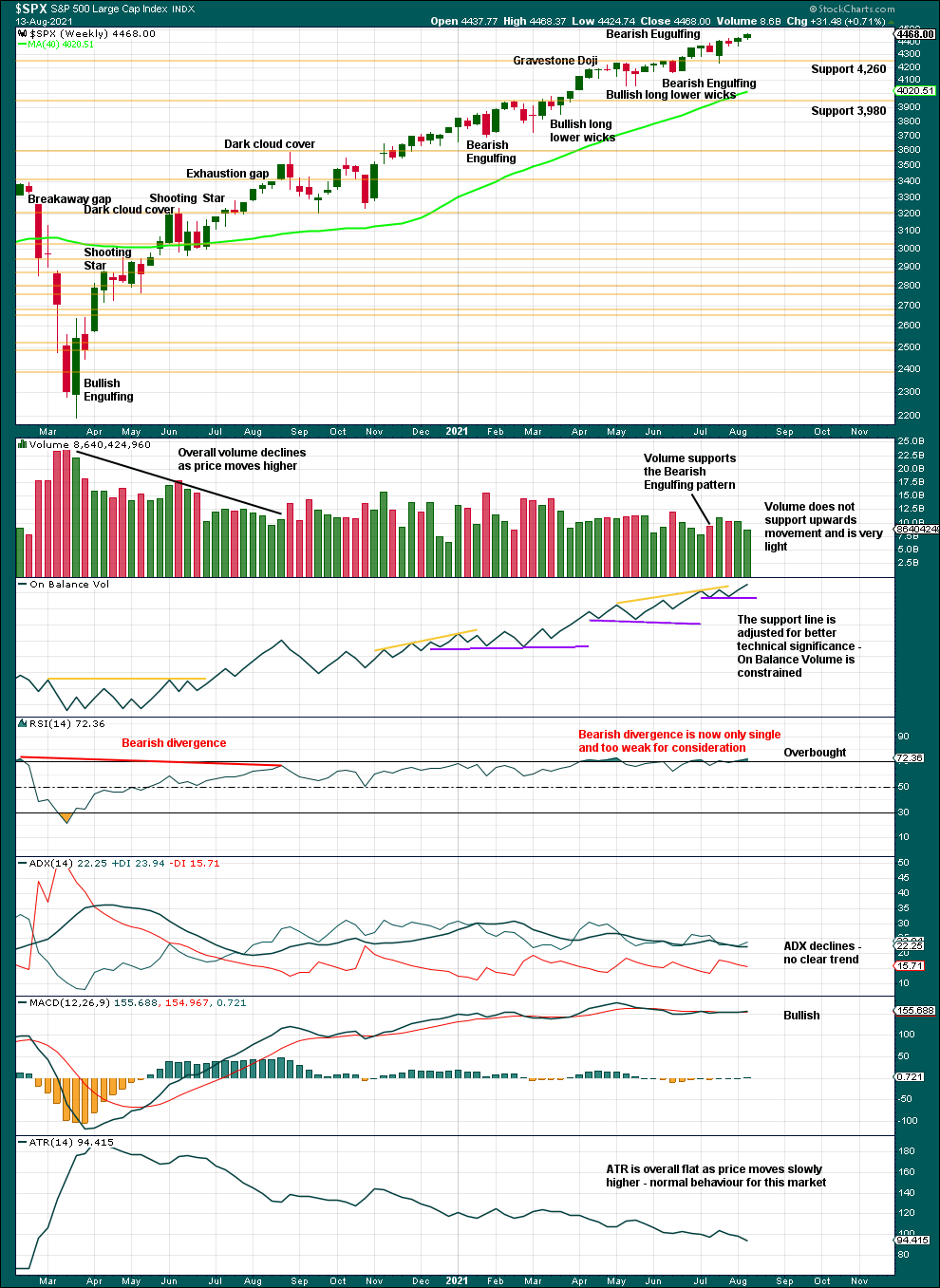
Click chart to enlarge. Chart courtesy of StockCharts.com.
Bearish divergence between price and RSI has almost disappeared this week. It is too small now for consideration.
This chart is bullish and does not support the main Elliott wave count. At this stage, it supports the first alternate Elliott wave count.
DAILY CHART
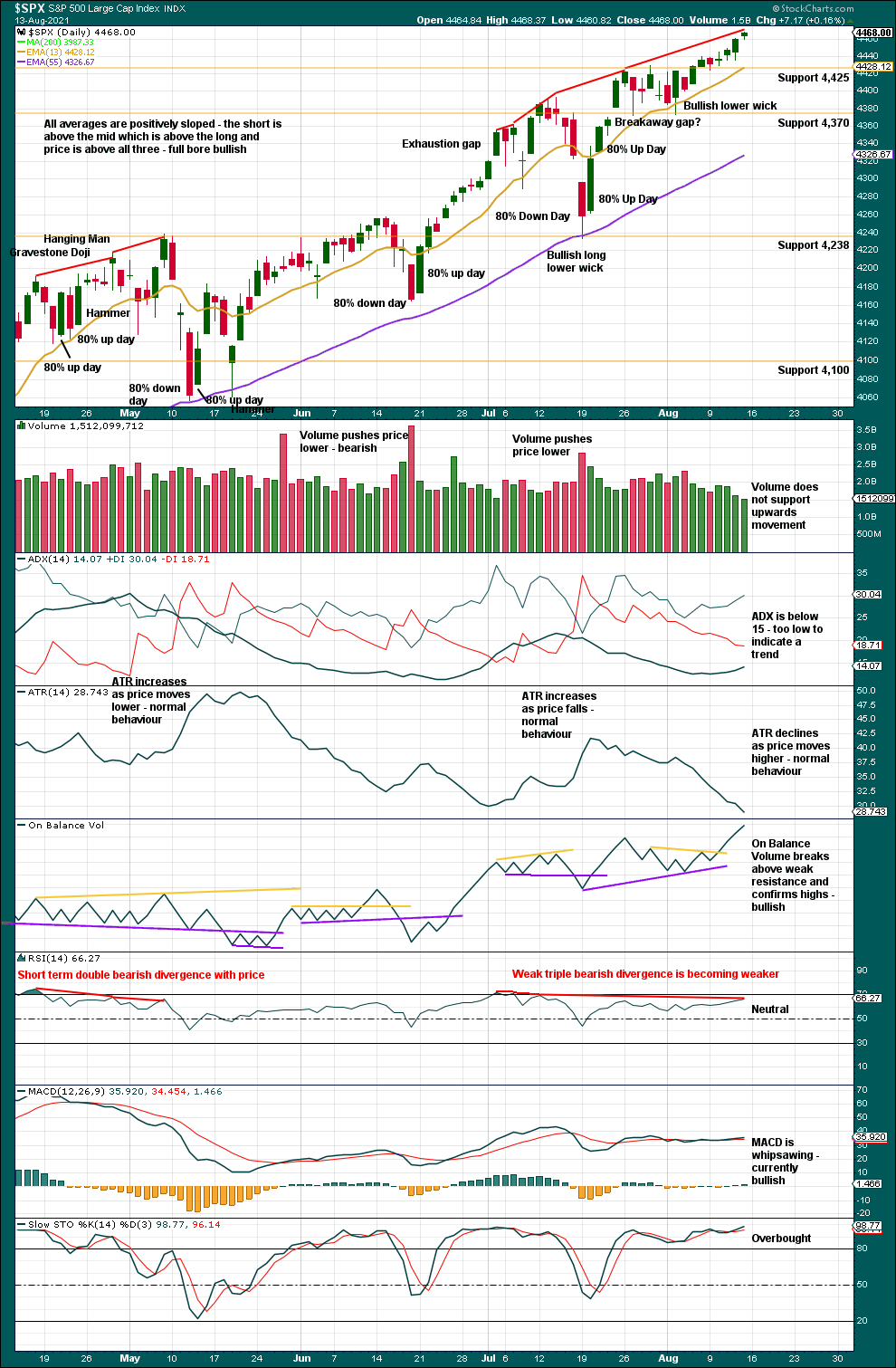
Click chart to enlarge. Chart courtesy of StockCharts.com.
It is possible that the weak short-term bearish divergence between price and RSI up to July 29th has been resolved by a short-term pullback to the low on August 3rd. So far divergence remains, but again today it continues to become weaker. The bullish case in the first alternate wave count is increasing in probability.
It is possible that another consolidation has completed and the bullish trend has resumed. If ADX reaches 15, it would give a strong bullish signal.
Overall, this chart too is bullish and supports the first alternate Elliott wave count. The only bearishness is weak volume, but this has often been evident in this market since 2008, so it is not of a concern given current conditions.
BREADTH – AD LINE
WEEKLY CHART
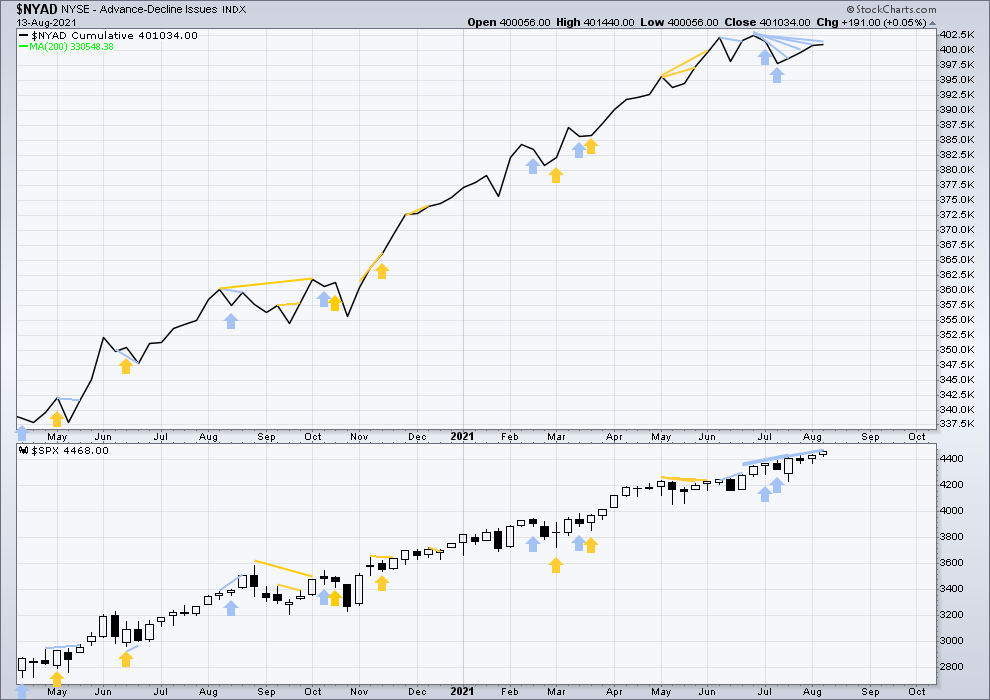
Click chart to enlarge. Chart courtesy of StockCharts.com. So that colour blind members are included, bearish signals will be noted with blue and bullish signals with yellow.
Breadth should be read as a leading indicator.
Lowry’s Operating Companies Only AD line has made a new all time high on the 8th of June. There is now just over two months of bearish divergence between the OCO AD line and price. This supports the main and second alternate Elliott wave counts but not the third alternate Elliott wave count.
There are only 30 sessions of bearish divergence between the NYSE All Issues AD line and price. This supports the main and second alternate Elliott wave counts but not the third alternate Elliott wave count.
Large caps all time high: 4,4468.37 on Aug 13, 2021.
Mid caps all time high: 2,780.08 on May 10, 2021.
Small caps all time high: 1,417.45 on June 8, 2021.
With 3 months of weakness in mid caps and 2 months of weakness in small caps, some pullback or consolidation may result soon.
Again, price has made new all time highs, but the AD line has not. The last all time high from the AD line was now six weeks ago. The gap is narrowing, but bearish divergence remains and supports the main Elliott wave count.
DAILY CHART
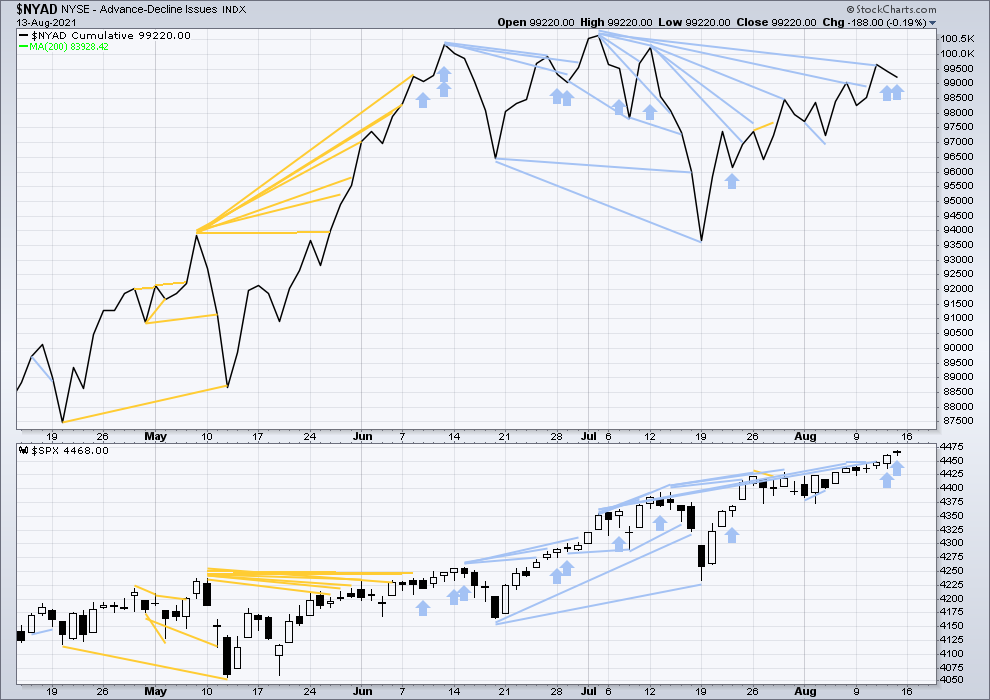
Click chart to enlarge. Chart courtesy of StockCharts.com. So that colour blind members are included, bearish signals will be noted with blue and bullish signals with yellow.
The NYSE All Issues AD line made its last all time high on July 2nd, 2021. There is over one month of bearish divergence. This suggests the market is currently vulnerable to a short-term pullback within the ongoing upwards trend. This is what the main Elliott wave count expects.
Price has moved higher for the second day in a row, but the AD line has moved lower. Upwards movement today did not have support from rising market breadth. This divergence is bearish and adds to an already reasonable cluster of bearish divergence, which supports the main Elliott wave count.
Today mid and small caps were particularly weak closing with reasonable sized red daily candlesticks. This offers support to the main Elliott wave count.
VOLATILITY – INVERTED VIX CHART
WEEKLY CHART
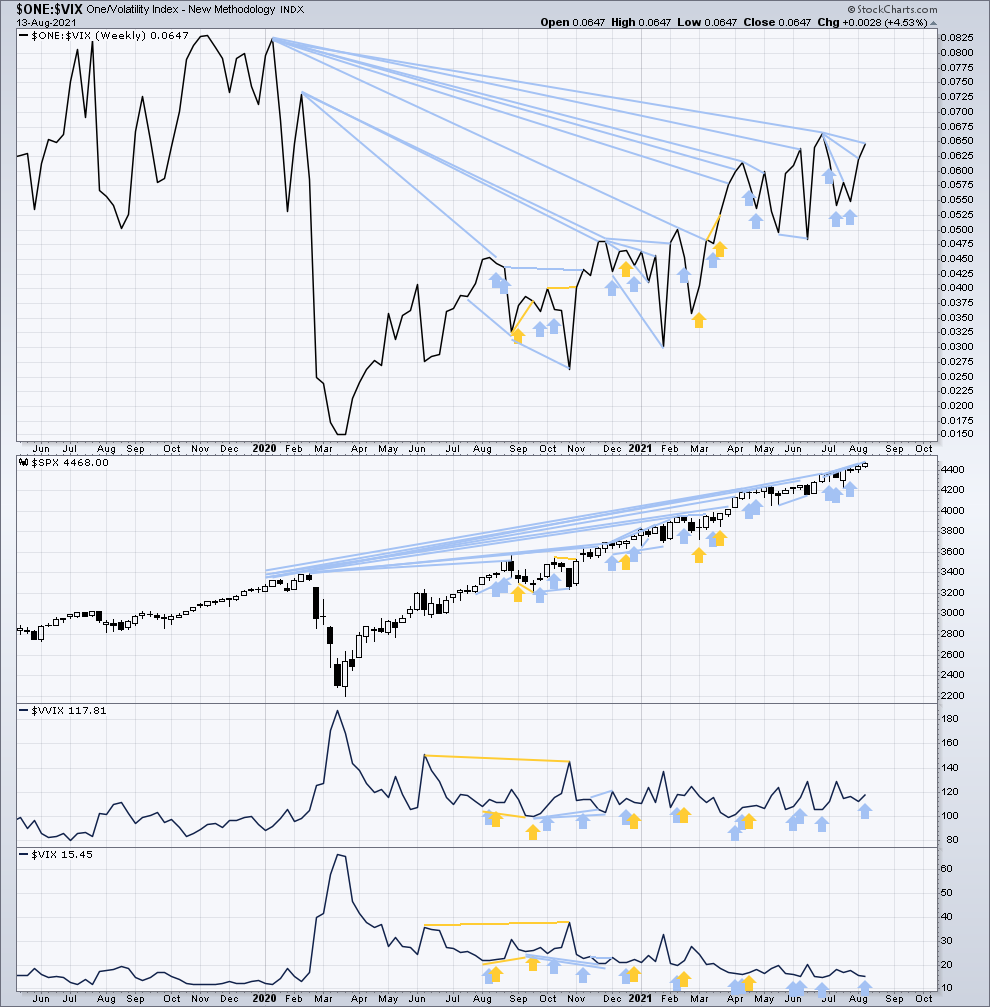
Click chart to enlarge. Chart courtesy of StockCharts.com. So that colour blind members are included, bearish signals will be noted with blue and bullish signals with yellow.
Inverted VIX remains well below all time highs. The all time high for inverted VIX was in the week beginning October 30, 2017. There is over 3 years of bearish divergence between price and inverted VIX. This bearish divergence may develop further before the bull market ends. It may be a very early indicator of an upcoming bear market, but it is not proving to be useful in timing. It may support the third alternate Elliott wave count.
Price and inverted VIX have moved higher this week. Price has made a new all time high, but inverted VIX exhibits all of short, mid and long-term bearish divergence. This supports the main or second alternate Elliott wave counts.
Comparing VIX and VVIX at the weekly chart level:
This week VIX has moved lower, but VVIX has moved higher. Volatility of VIX this week increased, which is bearish for price for the short term. This supports the main Elliott wave count.
DAILY CHART
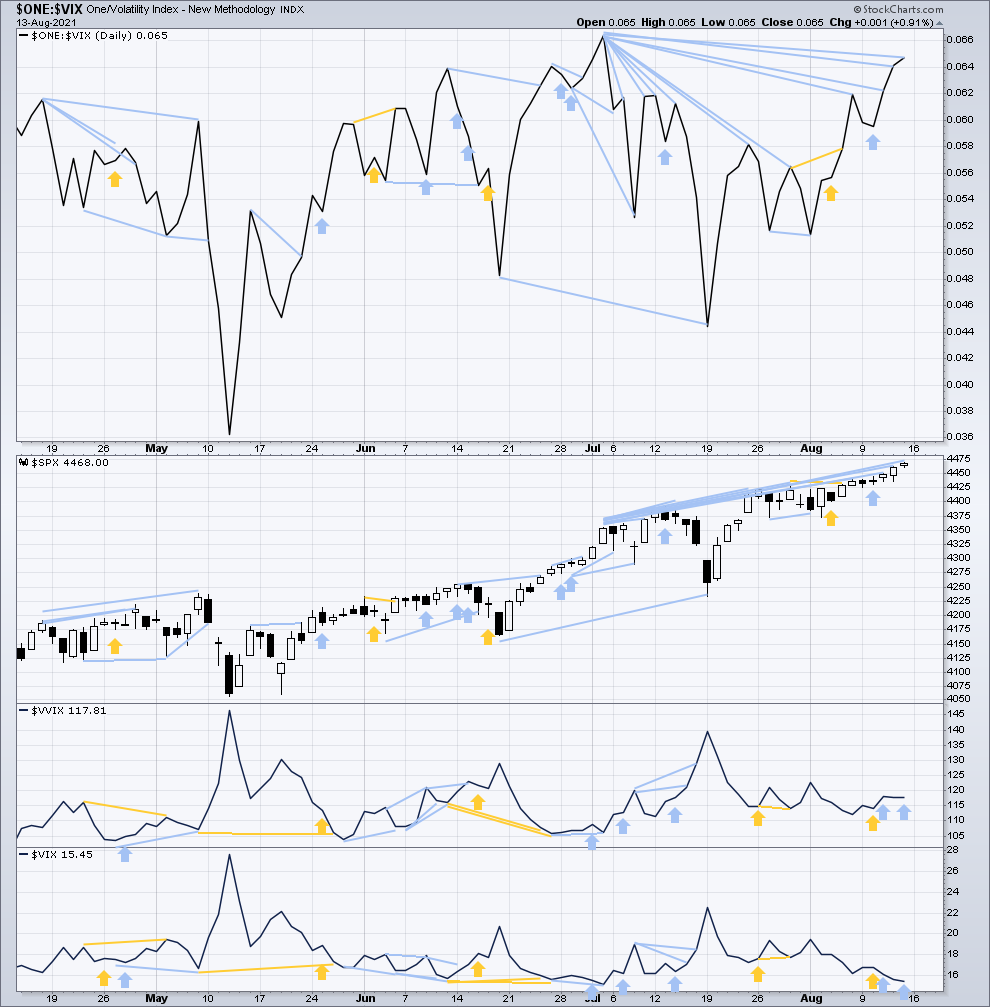
Click chart to enlarge. Chart courtesy of StockCharts.com. So that colour blind members are included, bearish signals will be noted with blue and bullish signals with yellow.
Both price and inverted VIX have moved higher. Price has made a new all time high, but inverted VIX has not made a new short, mid or long-term high. There is again all of short, mid and long-term bearish divergence. This supports the main, second alternate or third alternate Elliott wave counts.
Comparing VIX and VVIX at the daily chart level:
Today VIX has declined, but VVIX has slightly increased. Volatility of VIX remains elevated short term. This is bearish for price for the short term and supports the main Elliott wave count.
DOW THEORY
Dow Theory confirms a new bull market with new highs made on a closing basis:
DJIA: 29,568.57 – closed above on 16th November 2020.
DJT: 11,623.58 – closed above on 7th October 2020.
Most recently, on 10th May 2021 both DJIA and DJT have made new all time highs. An ongoing bull market is again confirmed by Dow Theory.
Adding in the S&P and Nasdaq for an extended Dow Theory, confirmation of a bull market would require new highs made on a closing basis:
S&P500: 3,393.52 – closed above on 21st August 2020.
Nasdaq: 9,838.37 – closed above on June 8, 2020.
The following major swing lows would need to be seen on a closing basis for Dow Theory to confirm a change from bull to a bear market:
DJIA: 18,213.65
DJT: 6,481.20
Adding in the S&P and Nasdaq for an extended Dow Theory, confirmation of a new bear market would require new lows on a closing basis:
S&P500: 2,191.86
Nasdaq: 6,631.42
GOLD
The target for the preferred Elliott wave count for more upwards movement was at 1,777 to 1,779. Price has reached 1,781.30 at the close of the week.
Summary: Both Elliott wave counts remain valid, but the bearish wave count is preferred. The bearish wave count expects the bounce to end here or very soon indeed. Thereafter, the mid-term target for the next wave down is at 1,568. For the short term, a new low below 1,751.48 would indicate the bounce should be over.
The bullish wave count now expects the bull market to resume to a target at 2,078.
The price point which differentiates the two wave counts at this stage is 1,677.64. A new low below this point would add strong confidence in the bearish wave count.
Grand SuperCycle analysis and last monthly charts are here.
BULLISH ELLIOTT WAVE COUNT
WEEKLY CHART
This wave count sees the the bear market complete at the last major low for Gold on 3 December 2015.
If Gold is in a new bull market, then it should begin with a five wave structure upwards on the weekly chart.
Cycle wave I fits as a five wave impulse with reasonably proportionate corrections for primary waves 2 and 4.
Cycle wave II fits as a double flat. However, within the first flat correction labelled primary wave W, this wave count needs to ignore what looks like an obvious triangle from July to September 2016 (this can be seen labelled as a triangle on the second weekly chart on prior analysis here). This movement must be labelled as a series of overlapping first and second waves. Ignoring this triangle reduces the probability of this wave count in Elliott wave terms.
Double flats are fairly rare structures. The probability of this wave count is further reduced.
Cycle wave IV may be a complete triple zigzag. Triple zigzags are not rare structures, but they are not common. The probability of this wave count is further reduced in Elliott wave terms. This is one reason why the bearish Elliott wave count is still considered.
Cycle wave V may have begun. Within cycle wave V: Primary waves 1 and 2 may now both be over, and primary wave 3 may have just begun. If it continues any lower, then primary wave 2 may not move beyond the start of primary wave 1 below 1,677.64.
DAILY CHART
A target is calculated for cycle wave V. If this target is wrong for this wave count, then it may be too low. As price approaches the target, if the structure is incomplete, then a higher target may be calculated.
Primary waves 1 and 2 within cycle wave V may be complete.
A target is calculated for primary wave 3. Primary wave 3 should exhibit an increase in upwards momentum and have support from volume.
BEARISH ELLIOTT WAVE COUNT
WEEKLY CHART
The bigger picture for this Elliott wave count sees Gold as within a bear market, in a three steps back pattern that is labelled Grand Super Cycle wave IV on monthly charts. Grand Super Cycle wave IV may be subdividing as an expanded flat pattern.
Super Cycle wave (b) within Grand Super Cycle wave IV may be a complete double zigzag. This wave count expects Super Cycle wave (c) to move price below the end of Super Cycle wave (a) at 1,046.27 to avoid a truncation and a very rare running flat. The target calculated expects a common Fibonacci ratio for Super Cycle wave (c).
Super Cycle wave (c) may have begun with a leading expanding diagonal for cycle wave I. Leading expanding diagonals in first wave positions are uncommon, so the probability of this wave count is reduced. However, it has a good fit and must be considered.
Second wave corrections to follow leading diagonals in first wave positions are usually very deep. Cycle wave II is deep and the structure may be complete; so far it is following a common pattern. If it continues higher, then cycle wave II may not move beyond the start of cycle wave I above 2,070.78.
DAILY CHART
A target is calculated for cycle wave III.
Primary wave 2 may be a complete double combination. Primary wave 3 downwards may have just begun. Primary wave 3 has now moved beyond the end of primary wave 1 at 1,752.19, meeting this core Elliott wave rule.
Intermediate wave (2) within primary wave 3 may not move beyond the start of intermediate wave (1) above 1,832.17.
At 1,568 primary wave 3 would reach 1.618 the length of primary wave 1.
Primary wave 3 may last a few months.
TECHNICAL ANALYSIS
WEEKLY CHART
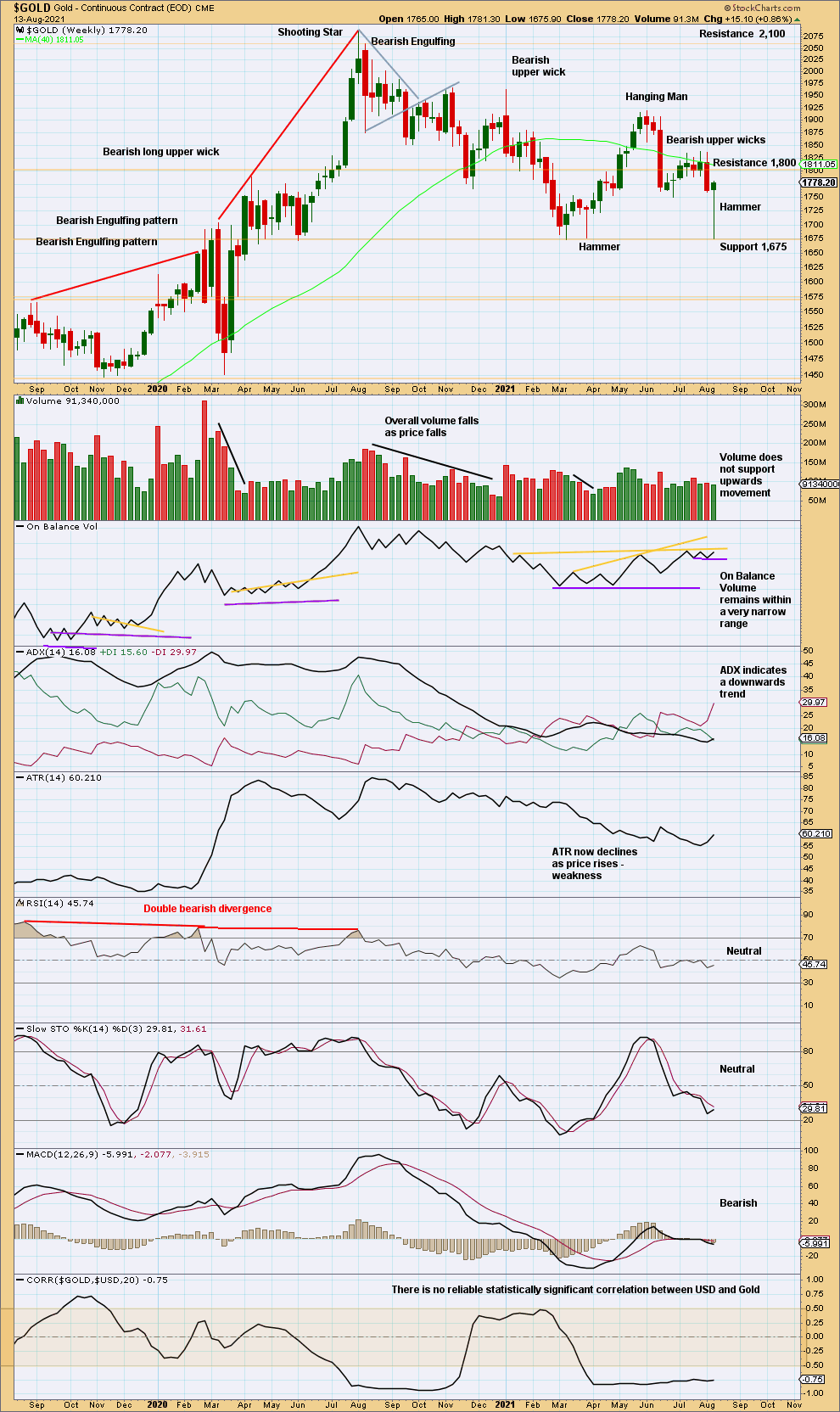
Click chart to enlarge. Chart courtesy of StockCharts.com.
Price has reached next support about 1,675 and bounced up strongly, completing a very bullish Hammer reversal pattern. However, ADX gives a strong bearish signal this week and volume has not supported upwards movement.
DAILY CHART
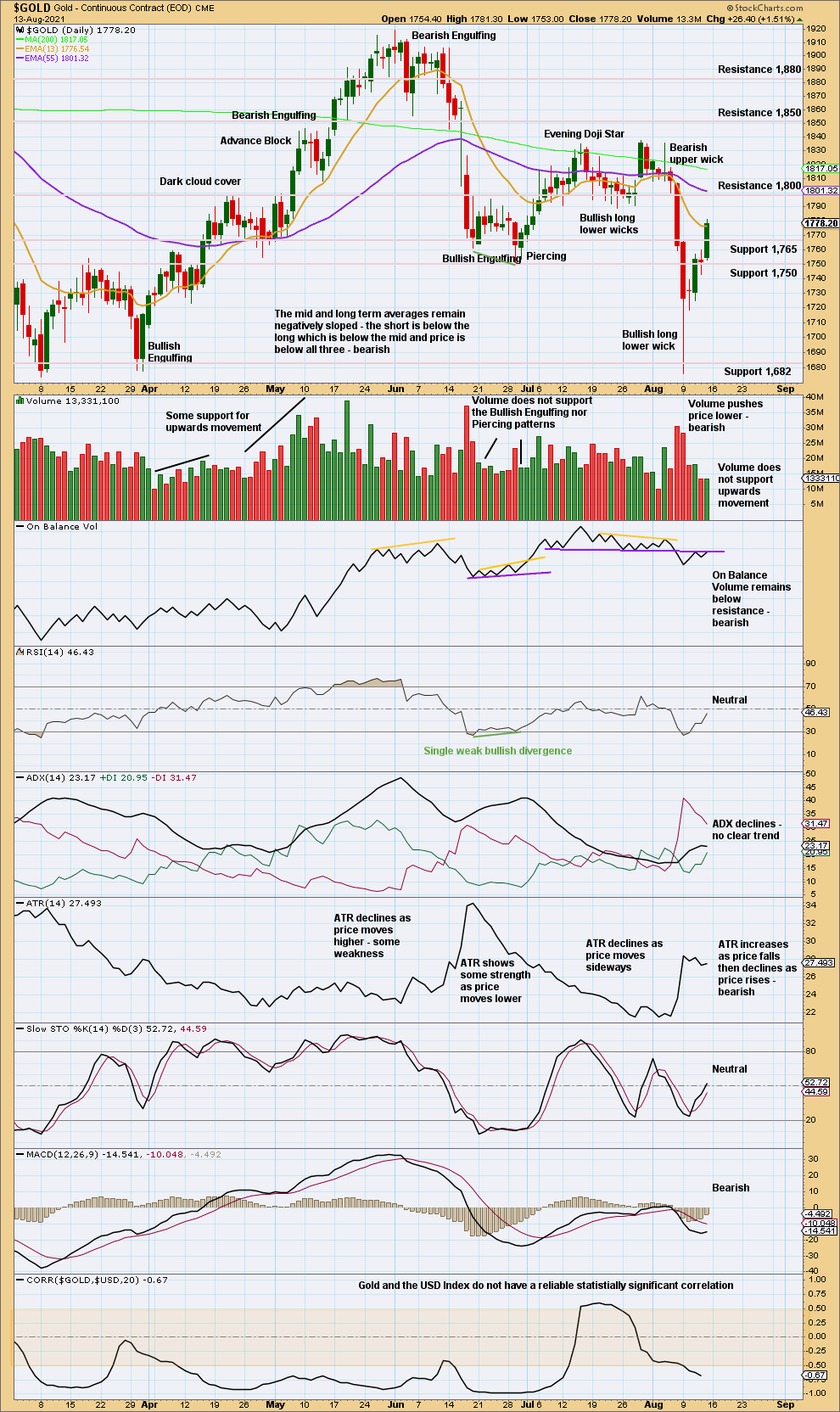
Click chart to enlarge. Chart courtesy of StockCharts.com.
Price is bouncing with weak volume and declining ATR. This looks possibly like a counter trend bounce to test resistance within a new downwards trend. Look for resistance about 1,800.
GDX WEEKLY CHART
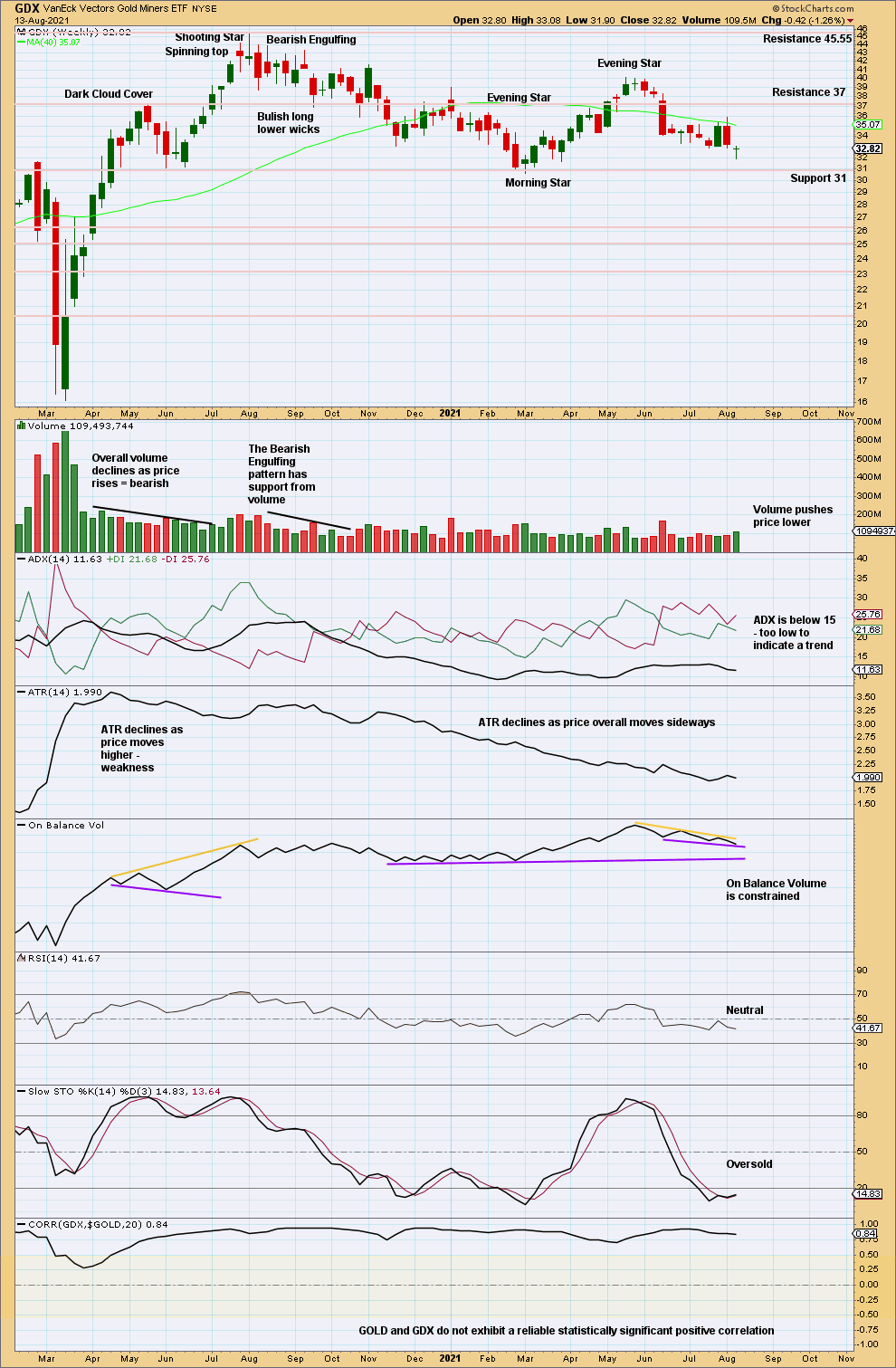
Click chart to enlarge. Chart courtesy of StockCharts.com.
There is still no clear trend at this time frame. Price is range bound.
GDX DAILY CHART
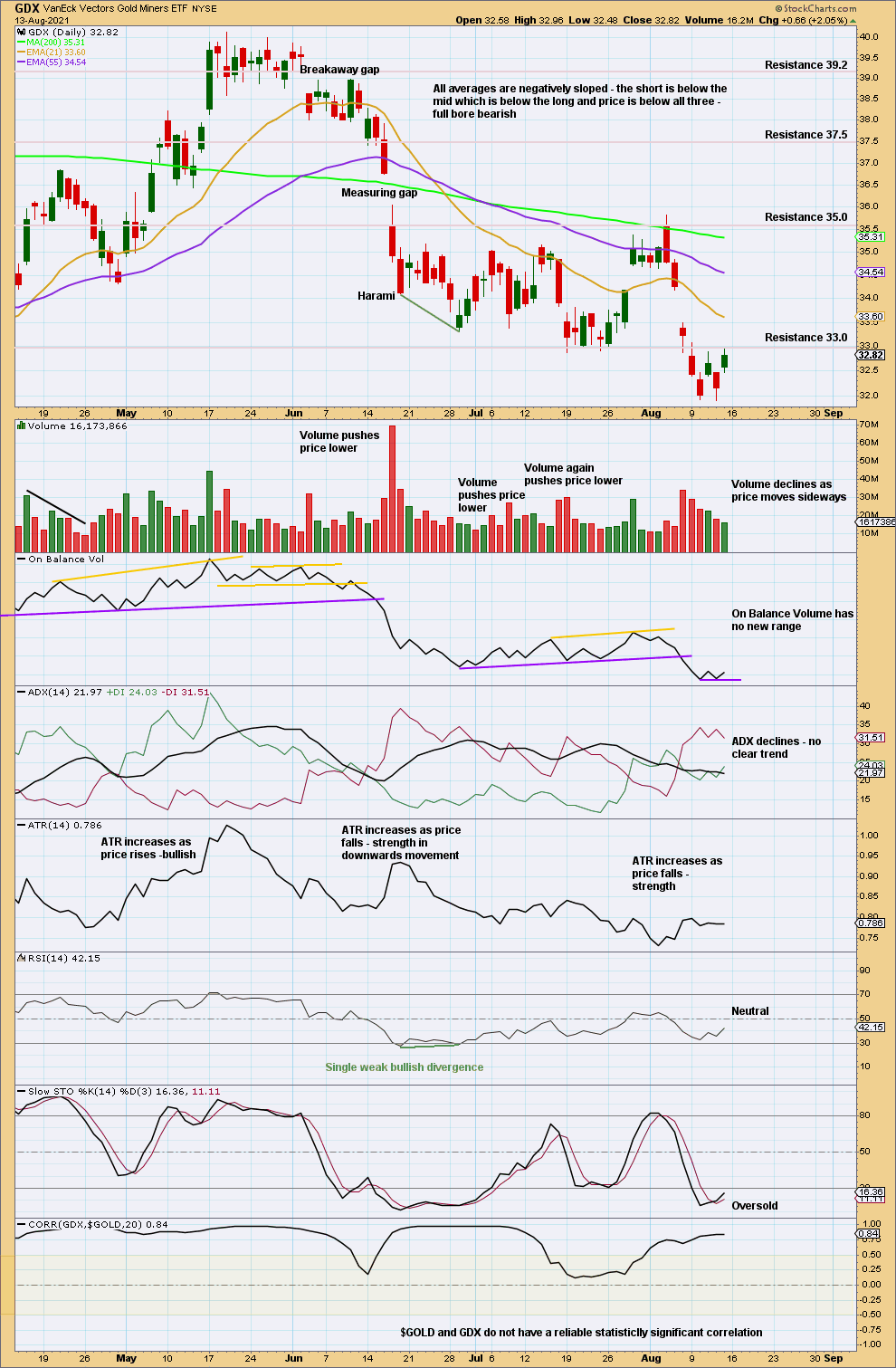
Click chart to enlarge. Chart courtesy of StockCharts.com.
This bounce looks most likely to be a counter trend movement. It may now have ended about resistance at 33.
US OIL
The main Elliott wave count expected upwards movement for this week. Price has moved lower and looks like it may close as a doji, with the low for the week falling just short of the short-term invalidation point.
Summary: The main Elliott wave count expects upwards movement to resume to the next target at 112.79.
An alternate Elliott wave count allows for more downwards movement to end at support at the lower edge of a channel on the daily chart.
Oil may have found a major sustainable low in April 2020.
ELLIOTT WAVE COUNT
MONTHLY CHART
The basic Elliott wave structure is five steps forward and three steps back. This Elliott wave count expects that US Oil has completed a three steps back pattern, which began in July 2008. The Elliott wave count expects that the bear market for US Oil may now be over.
Following Super Cycle wave (II), which was a correction (three steps back), Super Cycle wave (III), which may have begun, should be five steps up when complete. Super Cycle wave (III) may last a generation and must make a new high above the end of Super Cycle wave (I) at 146.73.
A channel is drawn about Super Cycle wave (II): draw the first trend line from the start of cycle wave w to the end of cycle wave x, then place a parallel copy on the end of cycle wave w. This trend line is breached to the downside, which is a typical look for the end of a movement for a commodity.
The upper edge of the channel has now been breached by upwards movement. This trend line may now have provided support for the last pullback; the pullback this week looks to have again found support at the upper edge of this channel.
A new high above the high at 76.90 from October 2018 has been made. This is a significant new high and was expected from this wave count. Further confidence in a bull market for Oil may be had.
Super Cycle wave (III) may only subdivide as a five wave impulse. New trends for Oil usually start out very slowly with short first waves and deep time consuming second wave corrections. However, while this is a common tendency, it is not always seen and may not have been seen in this instance. The first reasonably sized pullback may be over already.
WEEKLY CHART
Super Cycle wave (III) must subdivide as an impulse.
Cycle wave I within Super Cycle wave (III) may be incomplete.
Within cycle wave I: Primary waves 1 and 2 may be complete, and primary wave 3 may only subdivide as an impulse.
Intermediate waves (1) and (2) within primary wave 3 may be complete. Minor wave 2 within intermediate wave (3) may not move beyond the start or minor wave 1 below 57.26.
Draw an acceleration channel about primary wave 3. Draw the first trend line from the end of intermediate wave (1) to the last high, then place a parallel copy on the end of intermediate wave (2). Keep redrawing the channel as price continues higher. The lower edge of the channel has this week provided some support for another pullback. On the weekly chart the channel is drawn on a semi-log scale, and on the daily chart below it is drawn on an arithmetic scale. Use the channel on both scales.
DAILY CHART
Minor wave 1 within intermediate wave (3) may be complete at the last high. The last pullback may be minor wave 2. Minor wave 2 may have ended about support at the lower edge of the acceleration channel.
Minor wave 3 may only subdivide as an impulse. Minute waves i and ii within minor wave 3 may now be complete.
Minute wave iii may only subdivide as an impulse. No second wave correction within minute wave iii may move beyond its start below 65.15.
This wave count is very bullish. It expects a third wave at minor, intermediate and primary degree may have just begun. An increase in upwards momentum would be expected.
When third waves extend their subdivisions are also extended and take more time. It is normal to see the middle of an extended third wave begin with a series of first and second waves.
ALTERNATE WEEKLY CHART
It is possible that primary waves 1, 2 and 3 within cycle wave I are complete. If primary wave 3 was complete at the last high, then the last pullback may have been the start of primary wave 4.
Primary wave 3 exhibits no Fibonacci ratio to primary wave 1. Primary wave 3 at 43.32 is longer than primary wave 1, which was 33.53.
Primary wave 2 lasted 10 weeks and subdivided as a single zigzag. Primary wave 4 may subdivide as any Elliott wave structure; so far it will be labelled as a possible double zigzag, but this labelling may need to change as it unfolds.
Primary wave 4 should last a few more weeks to be in better proportion to primary wave 2. Primary wave 4 may not move into primary wave 1 price territory below 43.77.
Draw an Elliott channel about the impulse of primary wave 3. Draw the first trend line from the ends of primary waves 1 to 3, then place a parallel copy on the end of primary wave 2. Primary wave 4 may find support about the lower edge of this channel.
When the channel is drawn about primary wave 3 there is an overshoot at the upper edge for intermediate wave (1). It is normal to see an overshoot of the trend channel on the side of the direction of the trend, but it is normally the third wave within the third wave as this is normally the strongest portion of a third wave impulse. This wave count does not have a normal look with the channel.
ALTERNATE DAILY CHART
Primary wave 4 may unfold as any one of more than 23 possible corrective Elliott wave structures. So far it will be labelled as a possible double zigzag to move lower to find support about the lower edge of the Elliott channel, but it may also continue sideways as a combination, flat or triangle.
It would be most likely that primary wave 4 would not be over at the last low. It would look too brief in comparison to primary wave 2.
If primary wave 4 unfolds as a double zigzag as labelled, then it may end about support at the lower edge of the channel, which may be about 64.25.
TECHNICAL ANALYSIS
WEEKLY CHART
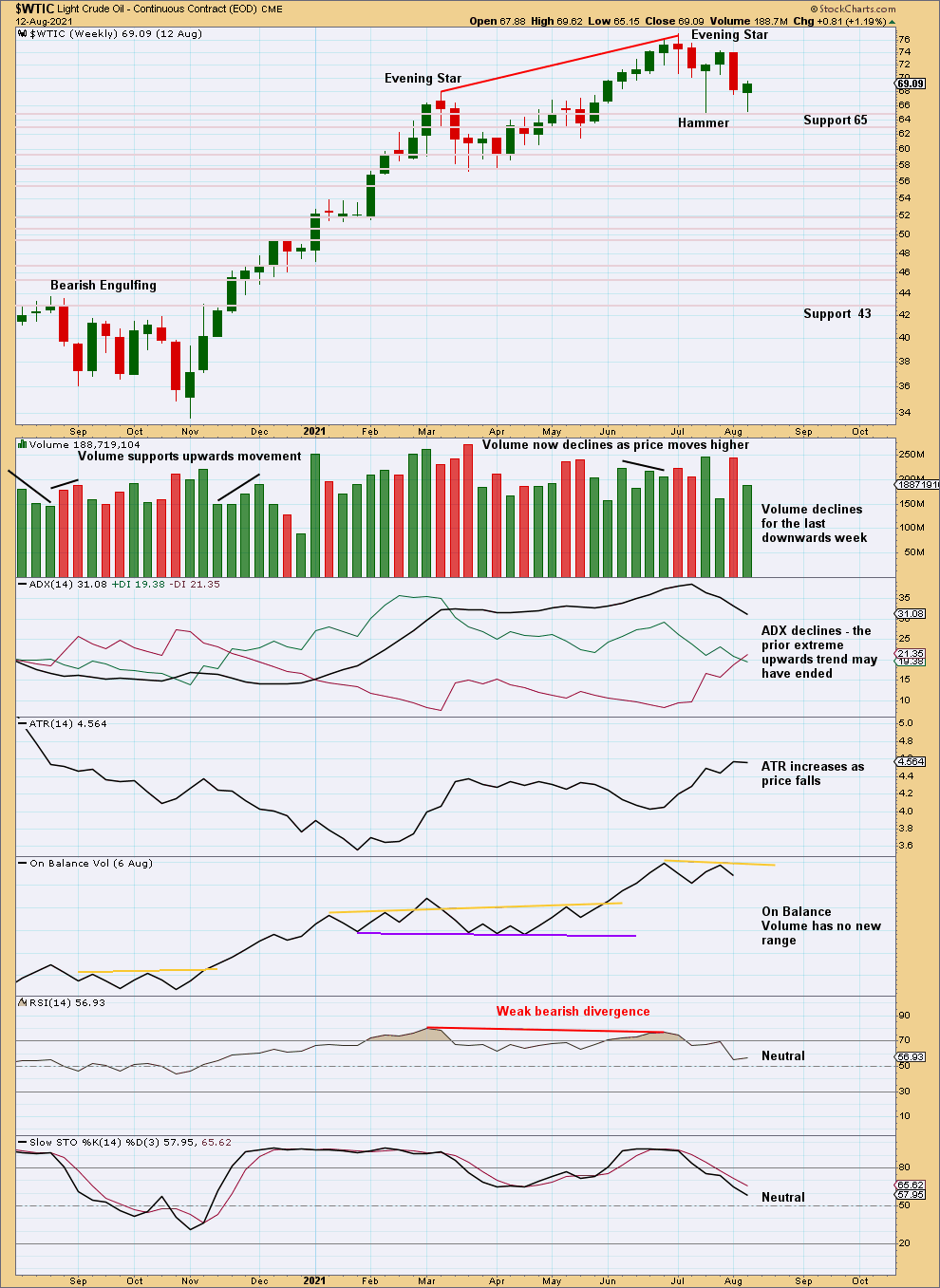
Click chart to enlarge. Chart courtesy of StockCharts.com.
A double bottom may have formed here at strong support about 65. The current weekly candlestick looks likely to close as another Hammer pattern. If so, then upwards movement would be likely next week.
DAILY CHART
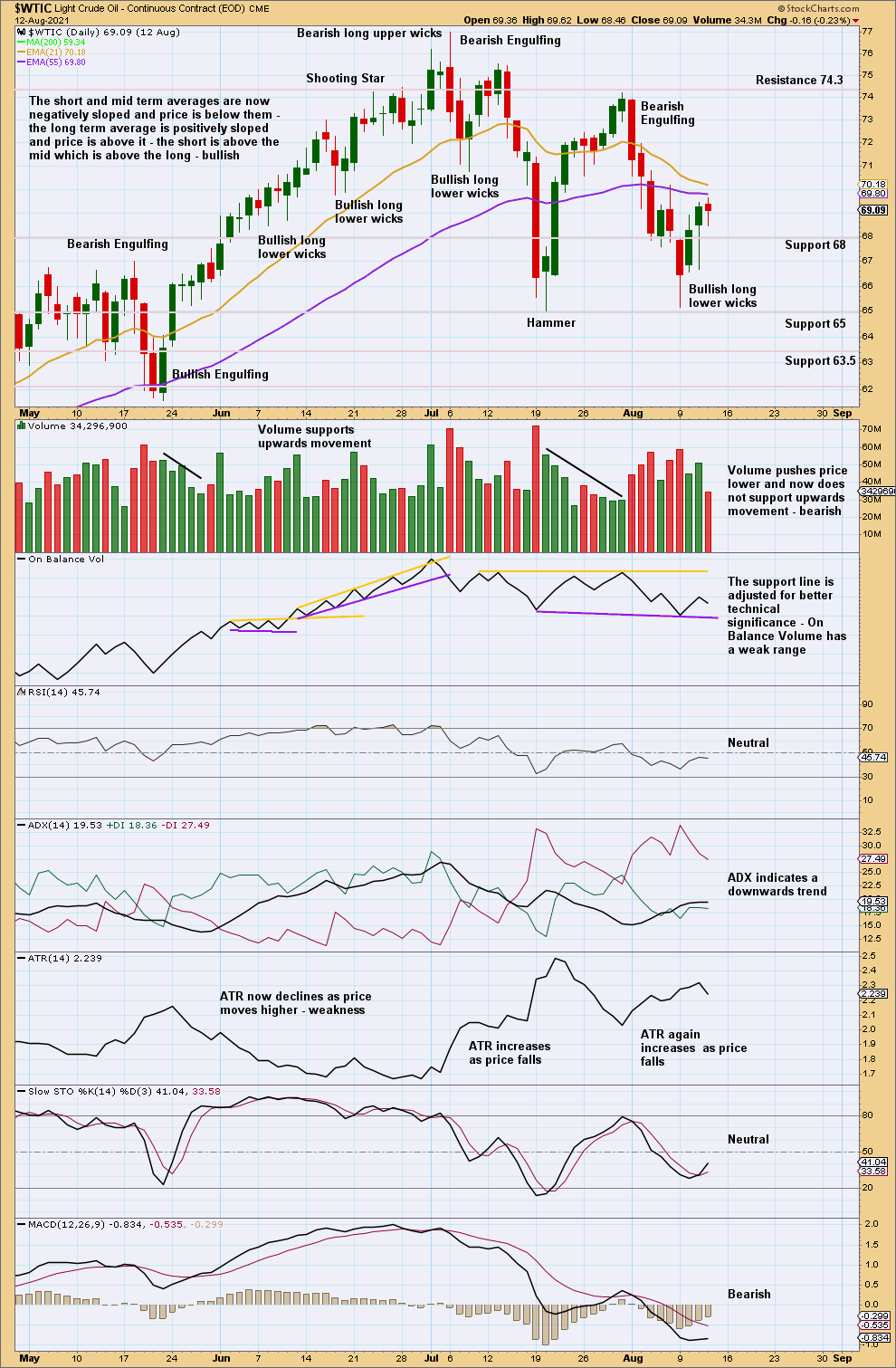
Click chart to enlarge. Chart courtesy of StockCharts.com.
Support at 65 has held, so technical strength there is increased. Bullish long lower wicks at the last low with support from volume for upwards movement suggest more upwards movement next week.
—
Always practice good risk management as the most important aspect of trading. Always trade with stops and invest only 1-5% of equity on any one trade. Failure to manage risk is the most common mistake new traders make.
—

